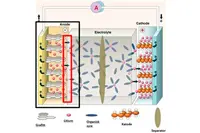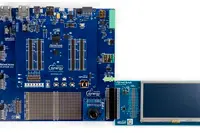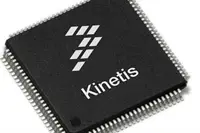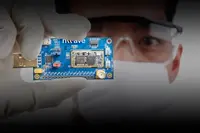Electronics News
Archive : 15 October 2015 год
 The US Consumer Product Safety Commission (CPSC) has approved a pilot programme to test an electronic filing system that will require those importing consumer products into the US to electronically submit five data elements.
The US Consumer Product Safety Commission (CPSC) has approved a pilot programme to test an electronic filing system that will require those importing consumer products into the US to electronically submit five data elements.
The measures are designed to enable the CPSC to enhance its surveillance of imported goods and to allow the accurate identification of noncompliant and unsafe consumer products before distribution within the US.
The pilot programme will be conducted jointly with US Customs & Border Protection (CBP). The CPSC, which is seeking volunteer participants, has scheduled the test programme to begin in the summer of 2016 and will run for approximately six months.
The five data elements are:
- Identification of the finished product.
- Each consumer product safety rule to which the finished product has been certified.
- Where the finished product was manufactured, produced or assembled, including the name and address of the manufacturer.
- The name and contact information of the testing entity.
- A check box indicating that a required certificate currently exists for the finished product.
Under the current system, manufacturers (including importers) and private labellers of certain regulated consumer products manufactured outside of the US are required to test and certify that such products are compliant with all regulations prior to importation. The certificates of compliance and product safety are made available to the CPSC by placing paper certificates inside shipping containers or by providing electronic certificates through an online system or via email.
The pilot programme will assess two options for the electronic filing of the certificate data: either filing all certificate data at the time of the product’s entry to the US; or filing a reference to certificate data stored in a registry maintained by the CPSC. The electronically filed information will be available to CPSC for validation and risk assessment.
Author
Graham Pitcher
Source: www.newelectronics.co.uk
 Researchers from the Norwegian University of Science and Technology (NTNU) are working on improving the solid electrolyte interphase (SEI) as a way to boost battery life.
Researchers from the Norwegian University of Science and Technology (NTNU) are working on improving the solid electrolyte interphase (SEI) as a way to boost battery life.
When a lithium battery is first charged up, a thin SEI film forms on the surface of the carbon anode. This film has a complex chemical structure containing both organic and inorganic lithium compounds. This protective coating is key in determining a battery’s lifetime, thermal stability and capacity, especially at high rates.
Lithium that is bound in the film doesn’t participate in charging the electrodes which results in reduced capacity. Ahmet Oguz Tezel, a PhD candidate at NTNU’s Department of Materials Science and Engineering, said: “Once the battery is assembled, we cannot add more lithium to the cell, therefore limiting the loss of available lithium in the cell is of prime importance for long lasting batteries.”
Tezel’s work has focused on modifying the composition of the electrolyte to achieve higher battery capacity and life span, especially at low temperatures.
He has also had promising results with his work with developing a preparatory treatment that prevents too much lithium loss in the formation of the SEI film. This allows more of the lithium in the electrolyte solution to participate in charging the electrodes.
State of the art electrolytes that consist of ethylene carbonate (EC), in principle, cannot operate when the temperature is at about -10°C, due to the high melting temperature of the EC. On the other hand batteries containing the organic compound propylene carbonate (PC) can work at temperatures as low as -50°C.
“We think that we found a way to substitute EC for PC, however we haven’t confirmed this yet,” Tezel said. “But our research suggests how it might be realised.”
Pic: Lithium in the highlighted layer cannot be used for charging or powering the battery. The goal is to limit the amount of lithium that is bound up in this layer. Key: grafitt = graphite; litium = lithium; organisk syre = organic acid; katode = cathode
Author
Tom Austin-Morgan
Source: www.newelectronics.co.uk
 A report from Deutsche Telekom claims the European smart homes market could be worth in excess of €19billion by 2019, when around 50million homes are expected to have installed some type of ‘smart’ technology.
A report from Deutsche Telekom claims the European smart homes market could be worth in excess of €19billion by 2019, when around 50million homes are expected to have installed some type of ‘smart’ technology.
However, the report – ‘How to Create Growth from the Connected Home’ – finds that while the connected home could represent an excellent opportunity for a broad range of European businesses, it might also pose a significant threat.
Deutsche Telekom says that the connected home will have a huge impact across a broad range of industries, from telecommunications and utilities to retailers and insurers and from appliance to consumer hardware manufacturers. Its report suggests that much of the value will come from new and real growth, although it concedes that the Internet of Things is likely to result in some of that additional value shifting from one sector to another. The report also suggests that businesses will have to move from ‘just selling’ hardware to offering hardware based services. This, in turn, will have a significant impact on business models, margins and routes to market.
“We believe this report is a wake-up call for European business,” suggested Holger Knopke, Deutsche Telekom’s VP for the Connected Home. “Global competitors are eyeing up opportunities in Europe and they will not sit around and wait for European players to fully prepare their strategies and product development plans.”
According to Knopke, there will be dramatic implications for businesses looking to supply products or services.
“We expect the smart home will lead to further commoditisation for many players, to the disintermediation of many others and dramatic changes in the relationship that brands have with other brands and their route to market.”
The report looks in detail at the technologies associated with the connected home and how they are likely to change the way in which homes operate, from micro ordering of consumables to saving energy and providing proactive maintenance of devices.
It warns that it is crucial that more companies look at partnering as the necessary industry wide platforms or consistent standards are not yet available. In fact, Deutsche Telekom urges companies to ‘abandon previous proprietary and closed approaches and open up to more collaboration’.
According to Jon Carter, head of connected home business development for Deutsche Telekom UK: “The connected home is set to be a huge market and while it has been talked about widely for many years it has changed fundamentally – it’s not simply analysts pumping out reports – it is actually happening as consumers and, more significantly, manufacturers begin to understand the value that the IoT can bring them. We’re seeing businesses revising their business models as a result.”
The report also highlights some of the opportunities provided by smart connectivity. “Among consumers, the applications currently driving the market are those associated with security, self monitoring and safety,” explained Carter. “Future growth, however, will depend on greater compatibility and interoperability.”
Despite industry enthusiasm, consumer awareness of the connected home concept remains low. A recent study by GfK found that 72% of households surveyed had never heard of it, but when it was explained to them and specific user cases outlined, 98% expressed an interest in the benefits it could bring.
“We need to ground what we do, in terms of the connected home, in the reality of what customers really want or need. There has tended to be too much hype around the connected home and there needs to be a clear value that consumers can buy into,” Carter concluded.
Pic: “There has tended to be too much hype around the connected home.” Jon Carter
Author
Neil Tyler
Source: www.newelectronics.co.uk
 There’s only a week to go before EDS 2015 – incorporating the Engineering, Electronics and Embedded Design shows – opens its doors to the UK’s design engineering community, with more than 200 companies exhibiting the latest innovations.
There’s only a week to go before EDS 2015 – incorporating the Engineering, Electronics and Embedded Design shows – opens its doors to the UK’s design engineering community, with more than 200 companies exhibiting the latest innovations.
Alongside the exhibition, being held once again at the Ricoh Arena in Coventry, the Electronics Design Show conference will provide 12 sessions running over two days, while the workshop programme will offer attendees 20 free practical and technical sessions.
According to the show’s organiser, Mark Allen Exhibitions, the content across all the conference and workshop sessions at this year's show has been reviewed by the Institution of Engineering Designers (IED), which represents the UK’s engineering and products designer community and, as a result, have all been approved for CPD certification.
So, not only will attendees be able to keep up to date with the latest engineering and design projects and solutions, but visitors who attend any of the free conference and workshop sessions will now be able to earn CPD points.
In order to collect a CPD certificate, visitors should head over to the IED on stand D48 at the show.
The Electronic Design Show, now in its third year, has succeeded in delivering what has been described as a thriving live event and exhibition dedicated to the needs of engineers.
According to National Instrument’s Mark Gradwell: “It provides somewhere where engineers can learn about new technologies and techniques; get up close and hands on with the latest tools, hear about the amazing work their peers are doing, and interact with suppliers, customers and colleagues.”
Headline sponsors of this year’s event include: Mouser Electronics, Digi-Key, RS Components, Avnet Embedded, Premier EDA Solutions and Altium.
Martin Brooks, Avnet Embedded’s VP EMEA, said: “The Electronic Design Show is a perfect forum for us to showcase our new solutions. It offers an opportunity for us to meet with key customers, in one location, as well as our suppliers; as well as providing us with a platform to meet potential new customers.”
Asked what Avnet Embedded’s focusing will be at the Show, Brooks said that the company would be reviewing IoT and IoE topology and trends, as well as discussing the huge market expectations that surround the developing market. “EDS will provide the Avnet Embedded team with the opportunity to demonstrate how to supply complete solutions to customers with real-world applications using technology.”
Among its distributor partners, Intel will be demonstrating the benefits of gateways and the options available with Wind River and McAfee, while congatec will expand on hardware to fulfil gateway requirements and will be presenting its IoT development kit.
“Since its inception, EDS has been able to deliver outstanding conference content,” said Ed Tranter, managing director of Mark Allen Exhibitions. And this year is no exception.
Embedded systems are a fact of life across a wide range of products and this year’s conference opens with Adam Taylor, chief engineer – electrical systems, e2v, discussing how embedded systems can be developed on schedule, on cost and on quality. In ‘Lessons from the trenches creating better embedded systems’ he takes a look at common design and verification techniques to help engineers better understand embedded system development.
The current state of mobile network technologies is discussed by EE’s principal network architect Professor Andy Sutton. Speaking at the opening session on day two, Prof Sutton will be reviewing the latest developments in LTE-Advanced and exploring the drivers and technologies supporting 5G in the future.
In his presentation, entitled ‘Enabling the Automotive IoT, Big Data hits the road’ Andrew Birnie, automotive MCU systems engineering manager for Freescale, will describe the electrical architecture of the future vehicle, the role of gateways and the future challenges for electronics and component suppliers to enable the future vehicle.
The conference and workshop programme is both comprehensive and compelling and this year sees the introduction of a panel session hosted by Doug Amos, director of NMI’s FPGA network.
The panellists, who will include: Adam Taylor, e2v, Clive Bunney, Swindon Silicon Systems Andy Culmer, ITDev and Richard York from ARM, will look at why engineers tend to ‘play safe’ using the technology they know, rather than using the best solution for their application.
“The panel will look to challenge assumptions,” said Doug Amos. “It is made up of experts and users and will compare and contrast different approaches including ASIC, embedded CPU, large area electronics and a variety of FPGAs.
“Our aim is to promote a renewed and closer examination of assumptions which may be costing design teams time and money and jeopardising their success.”
To see the full conference and workshop programmes and to register to attend the event, go to www.electronicsdesignshow.co.uk, where you will be able to reserve your seat at the sessions of most interest to you.
Author
Neil Tyler
Source: www.newelectronics.co.uk
 The IoT Security Foundation (IoTSF) has been set up to ensure that smart devices are safe to use and to encourage firms developing smart gadgets to focus on security.
The IoT Security Foundation (IoTSF) has been set up to ensure that smart devices are safe to use and to encourage firms developing smart gadgets to focus on security.
The launch, backed by companies like, BT, Intel and Vodafone, followed an eight month consultation and development process driven by NMI. According to NMI’s John Moor, security lapses have shown popular consumer devices to be vulnerable to cyber attacks. “We need to be careful because if we are not, then we could be sleepwalking into some big problems.”
The IoTSF, which will act as an educational forum, is also developing security guidelines for product developers. IoTSF will hold an inaugural conference in London on 1 December 2015.
Pic: John Moor, VP of marketing, NMI
Author
Tom Austin-Morgan
Source: www.newelectronics.co.uk
 In a move intended to speed time to market for IoT and other embedded applications, Renesas has launched the Synergy platform, making available what the company calls ‘professional software’, as well as a range of MCUs, tools and other solutions.
In a move intended to speed time to market for IoT and other embedded applications, Renesas has launched the Synergy platform, making available what the company calls ‘professional software’, as well as a range of MCUs, tools and other solutions.
Tim Burgess, senior director, multimarket solutions, said: “Our customers spend a lot of time doing non differentiating software development, dealing with drivers, middleware, rtos integration and connectivity issues.” Synergy is intended to address these issues and to allow designers to accomplish more than they could before.
According to Burgess, Synergy is a ‘complete qualified platform which can support design at the API level’. It features five key elements: scalable MCUs; professional software; development platforms; secure connectivity; and one stop support. “The Synergy Software Package brings together the ThreadX rtos, stacks, middleware libraries and an applications framework. It’s all about software,” he noted, “but hardware is also important.”
The S3 and S7 MCU families are available now. The S3 is based on ARM’s Cortex-M4 core running at 48MHz, while the S7 features the M4 core running at 240MHz. Two further families will be introduced: the S1, featuring the Cortex-M0+ core at 32MHz; while the S5, still being defined, is likely to be a ‘cut down’ version of the S7. All MCUs will feature a concentric footprint and, according to Burgess, ‘any peripheral on any device will be the same’.
“It different to anything we’ve done before,” Burgess concluded.
Author
Graham Pitcher
Source: www.newelectronics.co.uk
 Renesas has provided more details of the MCUs available in its Synergy platform. The S7G2 and S3A7 are said to be the first scalable MCUs to be optimised for software development.
Renesas has provided more details of the MCUs available in its Synergy platform. The S7G2 and S3A7 are said to be the first scalable MCUs to be optimised for software development.
MCUs from the S7G2 group feature a 240MHz ARM Cortex-M4 CPU core and 4Mbyte of flash, enough to accommodate the software needs of HMI applications today and in the future, says the company. Meanwhile, the S3A7 MCUs feature a 48MHz ARM Cortex-M4 CPU to deliver a hardware solution suited to power efficient HMI applications. Both groups are pin and peripheral compatible, allowing software developed for one MCU group to be used with the other.
The MCUs integrate support in silicon for touchscreen LCDs, including a capacitive touch sensing unit. The S7G2 has a configurable LCD colour graphics controller, while S3A7 MCUs have a segment LCD controller.
Design kits for both MCU families are also available. The DK-S7G2 kit, pictured, has a detachable 4.3in WQVGA colour touch LCD plus a VGA camera, while the DK-S3A7 kit has a detachable custom segment LCD and extensions for evaluation of Renesas’ capacitive touch technology. The kits feature a range of connectivity options, including a Bluetooth Low Energy 4.0 radio.
Renesas has also released the first product example for S7G2 MCUs. This provide developers with a complete example of an HMI end product implementation. The PE-HMI1 features a step by step approach, taking developers through the various choices, allowing them to use the design ‘as is’ or to alter it to suit their application.
Pic: Renesas' DK-S7G2 design kit
Author
Graham Pitcher
Source: www.newelectronics.co.uk
 Freescale has launched the Kinetis KW41Z, said to be the first multimode radio MCU to support concurrent operation of IEEE802.15.4 Thread and Bluetooth Smart/BLE while hosting associated applications.
Freescale has launched the Kinetis KW41Z, said to be the first multimode radio MCU to support concurrent operation of IEEE802.15.4 Thread and Bluetooth Smart/BLE while hosting associated applications.
The KW41Z features up to 512k of flash and 128k of RAM, allowing multiple networking stacks to run on one device. It also supports Bluetooth v4.2, with an on chip balun facilitating wider coverage, better interference immunity, lower power and complexity and fewer RF front end components.
“Freescale is recognised as a longtime industry leader in MCU innovation and we now are building on this leadership by redefining the state-of-the-art for wireless MCU connectivity,” said Emmanuel Sambuis, executive director, MCU and connectivity products, at Freescale. “As the secure Internet of Tomorrow continues to take shape, Freescale is showing the way for the rest of the industry.”
The Kinetis KW41Z MCU is likely to find application in a range of home devices, such as thermostats, home security systems and door locks. Alongside the ability to run applications, it features Thread connectivity, providing the ability to control these systems using a smartphone or tablet via BLE and to use BLE to join devices to the network securely.
The KW41Z is based on an ARM Cortex-M0+ core running at 48MHz and features a 2.4GHz transceiver supporting FSK/GFSK and O-QPSK modulations.
Demonstrations of the device are planned for the forthcoming ARM TechCon event. These will include a BLE controlled robot and a BLE heart rate monitor.
Author
Graham Pitcher
Source: www.newelectronics.co.uk
 Dialog Semiconductor has collaborated with Bosch Sensortec to create the world’s lowest power 12 degree of freedom smart sensor reference platform for gesture recognition. Applications are said to include wearable computing devices, immersive gaming, augmented reality and 3D indoor mapping and navigation.
Dialog Semiconductor has collaborated with Bosch Sensortec to create the world’s lowest power 12 degree of freedom smart sensor reference platform for gesture recognition. Applications are said to include wearable computing devices, immersive gaming, augmented reality and 3D indoor mapping and navigation.
The platform combines Dialog’s DA14580 Bluetooth SoC with three low power sensors from Bosch Sensortec: the BMM150 for thre axis geomagnetic field measurement; the BME280 pressure, humidity and temperature sensor; and the six axis BMI160, which combines a three axis accelerometer and three axis gyroscope in one chip.
The resulting unit, built on a 14 x 14mm PCB, consumes less than 500µA from a 3V coin cell when updating and transferring all data wirelessly to a smartphone.
Udo-Martin Gomez, pictured, Bosch Sensortec’s CTO, said: “The result of this close cooperation is the world’s lowest power Bluetooth Smart connected sensors platform. Higher functional integration and lower power consumption are key design goals for devices at the heart of mobile consumer electronic products. From our companies’ joint experience, we see many opportunities to deliver competitive advantages for our customers by creating smaller, highly integrated and more energy efficient smart connected solutions.”
Mark Tyndall, senior vp of corporate development and strategy with Dialog, added: “Our work with Bosch Sensortec is bringing together best-in-class Bluetooth, power management and sensor technologies that enable our customers to develop high performance, innovative products with exceptionally long battery life. Combining the complementary talents of our respective design teams enables us to keep customers at the forefront of technology as the IoT market continues to evolve.”
Author
Graham Pitcher
Source: www.newelectronics.co.uk
 The Weightless SIG has announced the launch of a complete Weightless-N development environment for low power wide area network connectivity in IoT projects. Weightless technologies offer open standard access to IoT connectivity IP with substantive competitive advantage over alternative proprietary LPWAN technologies.
The Weightless SIG has announced the launch of a complete Weightless-N development environment for low power wide area network connectivity in IoT projects. Weightless technologies offer open standard access to IoT connectivity IP with substantive competitive advantage over alternative proprietary LPWAN technologies.
The development kits include a desktop base station with the same functionality as a commercial grade base station. The SDK incorporates an ARM Cortex-M3 MCU with 128KBytes of flash memory. The kit also includes supporting software tools, Simplicity Studio and a GNU C Compiler (GCC), together with a complete user guide.
Weightless CEO, William Webb, said: “We’re keen to see LPWAN projects commence rapidly so to celebrate the launch we’re making it easy to engage with Weightless technology by offering a limited number of kits available for free.”
Yury Birchenko, CEO of Nwave Technologies, added: “We’re very excited to offer developers the opportunity to start designing their next IoT product immediately. We are engaging with a significant, diverse and global community of developers who have eagerly awaited the launch of a Weightless development environment”.
Weightless SIG Members get access to all of the open standard specifications, the test specifications, the test and certification programme and the right to sell product using the technology on a royalty free basis.
Author
Tom Austin-Morgan
Source: www.newelectronics.co.uk

